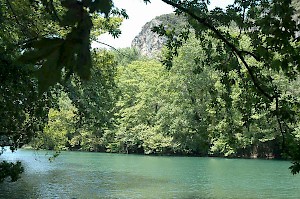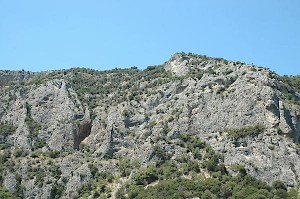Tempe
Q258540Tempe: canyon between the Olympus and Ossa.

The so-called "vale" of Tempe is the deep canyon between the Olympus and Ossa, where the swift river Peneus breaks through the mountains, and flows from Thessaly to the Aegean Sea. Tempe is about 25-50 meters wide, up to 500 meter deep and ten kilometer long.
There are splendid cliffs and the vegetation is lovely, so it comes as no surprise that the rugged landscape has always been praised by poets: e.g., Dio Chrysostom composed an Ekphrasis of Tempe, a description of the canyon. It is unfortunately lost. It was believed that the god Apollo had once chased the nymph Daphne into this canyon, but that she had changed into a laurel, which Apollo had transplanted from this canyon to the Castalian Spring in Delphi.
Tempe was and is the main road from Macedonia to Greece and used to be of some strategic significance. In 480, the Greeks (commanded by a/o Themistocles) tried to block the army of the Persian king Xerxes, who wanted to invade Greece, but discovered that their enemy could make a detour through passes in the Olympus range.note According to Polyaenus, the Macedonian king Alexander the Great was also shut out from Greece at this place, but was able to construct a stairs in the Ossa range (autumn 336). In 171, the last king of Macedonia, Perseus, tried to keep the Romans out of his kingdom at Tempe. The modern road is essentially the same as the road constructed by the deputy of Julius Caesar, Gaius Cassius Longinus, his future assassin.
In an interesting aside, the Greek researcher Herodotus of Halicarnassus tells that
the Thessalians say that Poseidon made the passage by which the Peneus flows. This is reasonable, for whoever believes that Poseidon is the "shaker of the earth" and that rifts made by earthquakes are the work of that god, will conclude, upon seeing that passage, that it is of Poseidon's making. It was manifest to me that it must have been an earthquake which forced the mountains apart. note

("Earth-shaker", was a homeric title of Poseidon.) In fact, the gorge has been created by erosion, but Herodotus' words prove that he was aware of the fact that the surface of the earth was subject to change.
In one of his letters, the Roman author Cicero says that the people of Reate compared the valley of the river Velinus to Tempe.note This probably only shows that the Reateans never visited the Greek canyon, because the valley of the Velinus is idyllic and tranquil, whereas Tempe is a defile full of contrasts. However, the authority of Cicero was sufficient to make later scholars believe that Tempe was a place of beauty and harmony; the now common expression "vale of Tempe" is simply wrong.